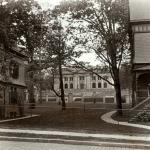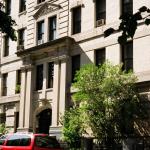 | ||||
 | ||||
Audubon Hall: Architectural Rendering
(click to enlarge)
 | ||||
The Fleischmann Brothers Company has sold the new six-story elevator apartment house at the southwest corner of Broadway and 157th Street [Audubon Hall], on a plot fronting about 115 on the plaza formed by the junction of Broadway, Audubon Place, and 157th Street. This is one of two similar structures recently completed by the sellers on the west side of Broadway, covering the block front from 156th to 157th Street, part of the old Audubon Park property.
New York Times
November 23, 1909
The Charles F. Noyes Company has secured on mortgage $510,000 at 4 1/2 per cent. for five years for the Aurora Investing Company, (Fleishmann Brothers). This loan covers two apartment houses, $265,000 being loaned on Hispania Hall, which occupies six lots on the northwest corner of Broadway and 156th Street, overlooking the buildings of the Hispania Society of American, and $245,000 on Audubon Court, covering five and a half lots on the southwest corner of Broadway and 157th Street, overlooking Audubon Park. These two apartment houses are now completed, and are considered among the best structures on upper Washington Heights. New York Times
December 23, 1909
Audubon Hall (600 West 157th Street)
Hispania Hall (601 West 156th Street)
The six-story Hispania Hall and Audubon Hall, which stretch between 156th and 157th Streets on the western side of Broadway, date from 1909. George Fred Pelham (1866-1937), whose many apartment buildings populate northern Manhattan, designed both. (You may remember that he is the architect who designed the six-story structures that the Grinnell family originally intended to erect along “their” Riverside Drive.) Like many apartment buildings in the area these buildings feature bases of rusticated stone, out of which rise brick upper stories.
If you look closely at the fence in front of Hispania Hall, you will notice that the Star of David is worked into the design. The precise reason has been lost in time, but the symbol does reflect the neighborhood's population in the 1930s, when many German Jewish refugees found a new home here. Within a few blocks of this corner were ten Jewish institutions, including the Prospect Unity Club, Lublo’s Palm Garden, and several synagogues.
Now, continue your walk to the corner and cross 157th Street, then turn left down the street. The back of the Grinnell, a nine-story apartment building that fills this triangular block, is on your right. If you direct your attention across the street, you will see the entrance to Audubon Hall, an identical twin to Hispania Hall's entrance that you saw a few minutes ago. Although both buildings front Broadway, their main entrances face the numbered streets. In the last few years, the building owner has remodeled the groundfloor storefront so that after decades of being hidden behind false partitions, it looks today very much as it did when the building was new.
Hortense Arms (602 West 157th Street)
The next building is the Hortense Arms. It stands on the site of a Queen Anne style house that George Blake Grinnell built for his eldest daugher Helen and her husband William Page in the late 1880s, shortly after they were married. Due west was a similar house the elder Grinnell built at the same time for his younger daughter Laura and her husband Newell Martin. William Milne Grinnell designed both houses.
The Reverend Mile Gates, rector of the Church of the Intercession, was the last resident of the Page house, which was the last house in Audubon Park to be demolished. Within a year, residents were moving into the Hortense Arms.
In September 1911, a New York Times advertisement describing the many amenties of the “just-completed” Hortense Arms, listed wainscoted dining rooms, beamed ceilings, serpentine glass doors and crystal chandeliers. Each apartment had a telephone, vacuum cleaner, steam clothes dryer and milk locker. And, “uniformed Otis Electric Elevator Service” was round the clock. The five-to-eight room apartments rented for $600 to $1,200 per year.
The Page and Martin Houses
(click to enlarge)
Hortense Arms
(click to enlarge)
Continue your walk . . .
Funded by the Audubon Park Alliance


